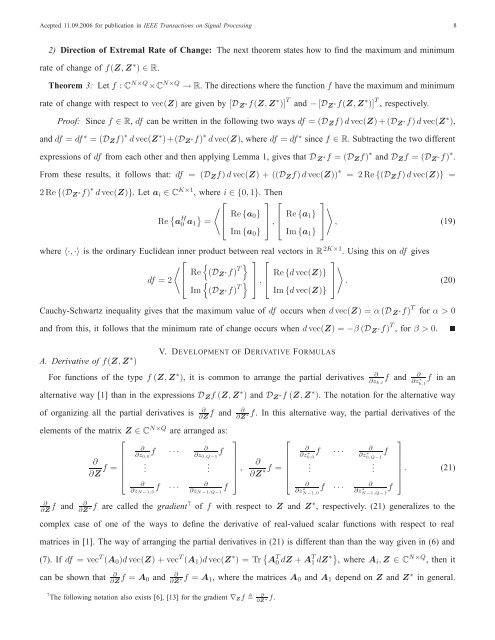Complex-Valued Matrix Differentiation: Techniques and Key ... - Unik
Complex-Valued Matrix Differentiation: Techniques and Key ... - Unik
Complex-Valued Matrix Differentiation: Techniques and Key ... - Unik
Create successful ePaper yourself
Turn your PDF publications into a flip-book with our unique Google optimized e-Paper software.
Acepted 11.09.2006 for publication in IEEE Transactions on Signal Processing 82) Direction of Extremal Rate of Change: The next theorem states how to find the maximum <strong>and</strong> minimumrate of change of f(Z, Z ∗ ) ∈ R.Theorem 3: Let f : C N×Q ×C N×Q → R. The directions where the function f have the maximum <strong>and</strong> minimumrate of change with respect to vec(Z) are given by [D Z ∗f(Z, Z ∗ )] T <strong>and</strong> − [D Z ∗f(Z, Z ∗ )] T , respectively.Proof: Since f ∈ R, df can be written in the following two ways df =(D Z f) d vec(Z)+(D Z ∗f) d vec(Z ∗ ),<strong>and</strong> df = df ∗ =(D Z f) ∗ d vec(Z ∗ )+(D Z ∗f) ∗ d vec(Z), where df = df ∗ since f ∈ R. Subtracting the two differentexpressions of df from each other <strong>and</strong> then applying Lemma 1, gives that D Z ∗f =(D Z f) ∗ <strong>and</strong> D Z f =(D Z ∗f) ∗ .From these results, it follows that: df = (D Z f) d vec(Z) +((D Z f) d vec(Z)) ∗ = 2Re{(D Z f) d vec(Z)} =2Re{(D Z ∗f) ∗ d vec(Z)}. Let a i ∈ C K×1 , where i ∈{0, 1}. ThenRe { 〈 ⎡ ⎤ ⎡ ⎤a H } ⎢ Re {a 0 } ⎥ ⎢0 a 1 = ⎣ ⎦ , ⎣ Re {a 〉1} ⎥⎦ , (19)Im {a 0 } Im {a 1 }where 〈·, ·〉 is the ordinary Euclidean inner product between real vectors in R 2K×1 . Using this on df gives〈 ⎡ ⎢ Re{(D Z ∗f) } ⎤ ⎡⎤T 〉df =2 ⎣ {Im (D Z ∗f) } ⎥ ⎢ Re {d vec(Z)} ⎥⎦ , ⎣ ⎦ . (20)T Im {d vec(Z)}Cauchy-Schwartz inequality gives that the maximum value of df occurs when d vec(Z) =α (D Z ∗f) T for α>0<strong>and</strong> from this, it follows that the minimum rate of change occurs when d vec(Z) =−β (D Z ∗f) T , for β>0.A. Derivative of f(Z, Z ∗ )V. DEVELOPMENT OF DERIVATIVE FORMULASFor functions of the type f (Z, Z ∗ ), it is common to arrange the partial derivatives∂∂z k,lf <strong>and</strong>∂∂z ∗ k,lf in analternative way [1] than in the expressions D Z f (Z, Z ∗ ) <strong>and</strong> D Z ∗f (Z, Z ∗ ). The notation for the alternative wayof organizing all the partial derivatives is∂∂Z f <strong>and</strong>elements of the matrix Z ∈ C N×Q are arranged as:⎡⎤∂∂∂z 0,0f ···∂z 0,Q−1f∂∂Z f = ⎢ ..⎥⎣⎦ ,∂∂∂z N −1,0f ···∂z N −1,Q−1f∂∗∂Zf. In this alternative way, the partial derivatives of the⎡∂∂Z ∗ f = ⎢⎣∂∂∂zf ···0,0∗ ∂zf0,Q−1 ∗.∂∂∂zf ···N ∗ −1,0∂zfN ∗ −1,Q−1.⎤⎥⎦ . (21)∂∂Z f <strong>and</strong> ∂∂Z f are called the ∗ gradient7 of f with respect to Z <strong>and</strong> Z ∗ , respectively. (21) generalizes to thecomplex case of one of the ways to define the derivative of real-valued scalar functions with respect to realmatrices in [1]. The way of arranging the partial derivatives in (21) is different than than the way given in (6) <strong>and</strong>(7). If df =vec T (A 0 )d vec(Z) +vec T (A 1 )d vec(Z ∗ )=Tr { A T 0 dZ + A T 1 dZ ∗} , where A i , Z ∈ C N×Q , then itcan be shown that∂∂Z f = A 0 <strong>and</strong>7 The following notation also exists [6], [13] for the gradient ∇ Z f ∂∂Z ∗ f.∂∂Z ∗ f = A 1, where the matrices A 0 <strong>and</strong> A 1 depend on Z <strong>and</strong> Z ∗ in general.
















